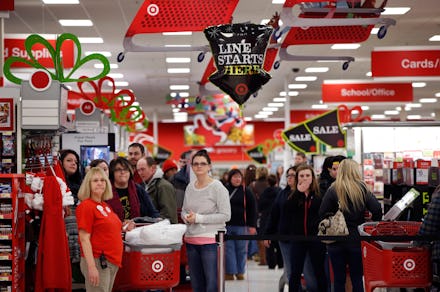Science Reveals Shoppers Have One Big Lesson to Learn From Monkeys

If Black Friday wasn't enough proof consumers are crazy, science has a disturbing lesson for American shoppers: When it comes to assessing value, monkeys do a better job.
Yale University researchers devised an experiment to test whether brown capuchin monkeys were susceptible to the same consumer pressures humans face — namely believing a bigger price tag and/or a brand name translated to higher quality. Their research demonstrated that monkeys were far thriftier and less prone to perception than their more evolved counterparts.
The study: We can learn a lot about consumer behavior from monkeys. A separate Yale study from 2006 proved capuchins possessed at least a cursory understanding of currency. When given a finite number of tokens with which to "purchase" food, the capuchins chose the thriftiest option given to them: three apple slices for one token as opposed to one grape.
Armed with this knowledge, the researchers behind this year's study tried to see if capuchins could be manipulated in the same way humans are.
In the first phase of the experiment, scientists gave the monkeys orange ice and blue ice to snack on in equal quantities, with neither monkey showing an overwhelming preference for either color.
The experiment's next phase added prices to the mix. Researchers gave the monkeys a token and assigned a "price" to each ice color. One token could warrant one piece of "expensive" blue ice or three pieces of "cheap" orange ice.
The last phase let the monkeys choose pieces of ice for free again. Despite being able to get the "expensive" ice for free now, the monkeys didn't choose it any more than they did in the first phase, before the researchers introduced a price bias.
The result? The monkeys did not conflate high price and high quality.
So why is this important? Because when a similar study was performed on humans in 2008, they performed worse than the monkeys, showing how humans are far more prone to certain biases when they walk through the sliding doors into Walmart.
The 2008 study presented subjects with two options: They could take a free bottle of 2001 pinot noir valued at $10 or a $50 pinot noir from the same year. Most people chose the more expensive option. This same study took the experiment even further. Researchers put the same wine into different, unmarked cups and told drinkers the wine in one cup cost $5-$10 and the other cup cost $45-$90. Despite being the same wine in each cup, participants reported the expensive wine tasted better.
While monkeys did not erroneously associate higher cost with higher quality, humans did.
Humans are easy to fool with numbers. As the Atlantic's Derek Thompson reported, retailers employ an array of tricks to manipulate shoppers into thinking they're getting a good deal when they're getting shafted such as artificially marking things up just to discount them or move comparatively cheaper merchandise, and even designing menus, endcaps and storefronts to draw attention to items with high profit margins.
As Thompson, wrote:
There are two broad reasons why these kind of tricks work. First: Consumers don't know what the heck anything should cost, so we rely on parts of our brains that aren't strictly quantitative. Second: Although humans spend in numbered dollars, we make decisions based on clues and half-thinking that amount to innumeracy.
The takeaway: Most of us have no idea what we're doing when we're shopping. We are more clueless than monkeys in regards to the prices behind our purchases and why we're purchasing them in the first place. When we have to look down the evolutionary ladder for inspiration in our shopping habits, that's how we know consumer culture has gone too far.
Price doesn't mean quality. "On sale" doesn't mean it's a good value. If enough shoppers do their homework, maybe our species can outsmart the monkeys one day.